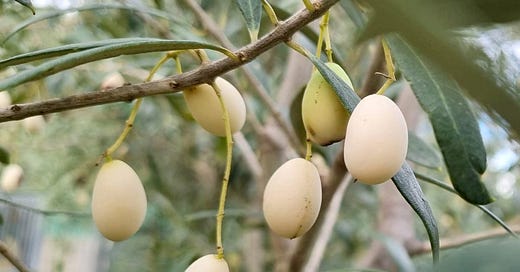Meet the Filmmaker 🍈
What are White Olive Trees and Why is Elena Valeriote Making a Film About Them?
Hi from Kerala India! I made the 20-hour journey yesterday and am now writing from Kochi, a city on the Arabian Sea. I am going on a week-long culinary tour and will be documenting on Instagram if you’d like to learn more about the food and agriculture of Southern India.
Elena Valeriote is a storyteller – a documentary producer, journalist, photographer, and novelist. The stories she is most interested in telling are centered on a strong sense of place and the belief that human beings are a part of – and not separate from – nature.
Elena has over a decade of professional experience in journalism. Her writing explores topics related to food, farming, travel, and culture, and has been featured in American and Italian publications including Eater, Gastro Obscura, Life & Thyme, and Modern Farmer.
When I first met Elena, we had so much in common and I wanted to learn more about the projects she was working on and her time in Italy. When she told me about these white olive oil trees, I could see why she would devote her time to telling the story of this tree and the people working to save it.
Living part-time in Italy, what are some of the ways in which Italians live differently than Americans in your experience?
Especially when it comes to food, in my experience, Italians are much more closely connected with the food that they eat than many Americans. Of course, this is not true for all people living in Italy, the country does have its own industrial and international food system, but in my time living in both cities and rural communities in Italy, I have found that people tend to know a lot more about where their food is coming from and who is growing or raising it. For certain products that play an especially important role in Italian culinary, agricultural, and cultural traditions (like olive oil, wine, or cheese) many are on a first-name basis with their favorite farmers. Oftentimes they buy these products directly on the farm or from local market vendors. It makes the whole experience of shopping, cooking, and eating profoundly meaningful.
You spent some time working on a risotto farm. What is the difference between commodity grown rice and rice grown regeneratively?
The farm that I worked on is certified organic and it is near another rice farm that grows their grains “conventionally” – meaning that they spray the crops with toxic chemical substances like pesticides and herbicides. It’s easy to see the difference in the two fields. The conventionally grown rice paddies are perfectly tidy and uniform. By comparison, the organic fields look wild and messy because they are full of weeds. The entire sensory experience is very different – the former fields are silent and still, while the latter hum with life, including dragonflies, frogs, and migratory birds. In this way, you can feel precisely how rice that is grown according to regenerative agricultural practices truly generates life. The plants are not just food to feed humans, but a habitat for a variety of small creatures. Growing rice requires a lot of water and can be hard on the soil, but integrating regenerative techniques can reduce water use and restore nutrients to the land.
Your most recent project is about the white olive oil tree. Can you share a little bit about that and why you were drawn to it?
I am currently in the process of producing a documentary about a rare type of tree that produces white olives. While almost every other olive in the world will eventually turn black, these particular fruits lighten over time until the trees look like they are strung with pearls. It was this unique quality that originally drew me to them, and I fell quickly and deeply in love in a way that couldn’t be limited to a single article of a few hundred words.
The story of the white olive tree is deeply rooted in Calabria, which is where my family comes from. It is uncertain how many trees continue to grow in the wild today, but one woman – the protagonist of the documentary – has devoted herself to mapping out the trees and has discovered just over one hundred trees so far. The climate crisis poses a significant threat to the trees, which are endangered by the increasing frequency of high temperatures, drought, wildfires, and pest infestations. My interest in making this documentary is partly motivated by the hope that raising awareness about the white olive trees can help prevent their extinction, but it is also because I find so much beauty in the relationship between the Calabrians and these trees. Read more here.
While immersing yourself in that, what have you learned about the human reaction to species going extinct
Working on this documentary has meant that I spend a lot of time considering the biodiversity crisis that we are currently living through, which comes with a fair amount of feeling heartbroken and overwhelmed, but more than anything, this project has filled me with hope. I have seen firsthand the power of a single individual to galvanize a group and make real, positive change in a short period of time. When humans feel connected to the natural environment in which they live, they become invested in caring for it. The book The Moth Snowstorm by Michael McCarthy was very influential in informing my understanding of this idea, but it has been particularly inspiring to see it in action through this community in Calabria.
You write such interesting pieces that cover the breadth and depth of the food and agriculture world. can you share a bit about your process for finding a new story and pitching it? Are your eyes and ears always open or do publications bring these incredible stories to you?
My eyes and ears are absolutely always open! For better and for worse, there is very little separation between my work and the rest of my life. I am truly passionate about what I do and am immersed in it at all times, seeking stories online and out in the real world. I am reading and researching topics related to agriculture and climate daily, but I also find plenty of inspiration on farms and at farmers markets, in restaurants and grocery stores. Almost everything that I have written has come from an original pitch of my own creation that started with discovering an idea and wanting to spend more time with it. I love journalism because it legitimizes my curiosity and allows me to always be learning.
Gems of the Week ✨
This marinated chickpea dish by
Got these Teva sandals for my trip and so far they are cute and comfortable
Learning a lot from the
newsletter, loved this piece on the nutrition of faux-meat burgersRevealed: Tyson Foods dumps millions of pounds of toxic pollutants into US rivers and lakes
I am watching Baby Reindeer and yes it is good and yes it is upsetting.
Last week I got to meet up with my Dad in New York for an afternoon coffee and snack. We happened to be near Grandaisy Bakery and I felt intrigued to try this focaccia w/ grapes.
We both loved the chewy texture with the sweet burst of tiny grapes. This bread is a traditional Italian bread from the Tuscany region celebrating the grape harvest called Schiacciata con l'Uva. It’s not really the season for Concord grapes, but if you happen to come across them, this recipe looks delicious and I will be trying it when I’m home.








